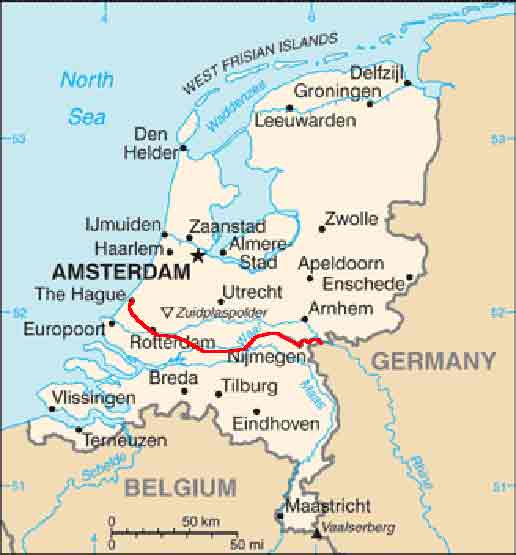francobollo (i)
sello de correos (s)
Briefmarke (G)
selo postal (P)
postage stamp (E)
arnhem, netherlands
September 17-26, 2024, marked the 80th anniversary of Operation Market Garden. 80 years earlier, in June 1944, the Allies landed on the beaches of Normandy, fought their way inland and liberated France and Belgium, including the liberation of Paris on August 25, 1944. By September 1944, the Allies were approaching the German border. But their supply lines were stretched thin and progress had to slow, allowing the Germans to retreat to their Siegfried Line, a system of tunnels, tank traps, minefields and bunkers which ran the length of Germany from the Netherlands all the way to Switzerland.
The Allies recognized that progress as they entered Germany would be slow and the fighting would be fierce. The English general, Sir Bernard Montgomery, devised a plan, relying greatly on airborne assets, to invade the Netherlands (which had been occupied by Germany since May 1940); take key bridges across the Rhine River; and advance into northern Germany by going around the northern end of the Siegfried Line. The goals of the plan, code named Operation Market Garden, were to liberate the Netherlands; gain access to the Ruhr Valley, the heart of German’s industrial area; and shorten the war.
According to the plan, bridges over the Rhine at Eindhoven, Nijmegen and Arnhem would be seized by members of the 101st and 82nd United States Airborne Divisions as well as 1st British Airborne division, who would land by parachute and glider. Once the bridges were seized, the British 30 Corps were then to cross the Rhine. The operation began on September 17, 1944, and eventually all of the bridges were captured.

But Operation Market Garden failed, and the Allies sustained horrendous losses. In fact, it was the last Allied defeat of World War II. The failure was mainly due to the inability of the British 30 Corps to reach the bridge at Arnhem before German forces and tanks overwhelmed the lightly defended airborne forces (who had landed more than seven miles from the bridge and did not all make it to the bridge at Arnhem.) The British 30 Corps ended up traveling along a narrow causeway surrounded by marshes, subject to traffic jams and German attacks. On September 24th, surviving American troops were ferried back across the Rhine. Estimates are that the Allies lost over 17,000 troops. Operation Market Garden did accomplish the liberation of large portions of the Netherlands, whose population was facing a winter of starvation. Arnhem was destroyed and its 90,000 inhabitants evacuated.
One of Arnhem’s now most famous residents had left Arnhem for Velp, a town nearby, just before Operation Market Garden started. Her grandfather, Baron Aarnoud van Heemstra, served as Mayor of Arnhem from 1910 to 1920, living at the beautiful ‘Huis Zypendaal’. In September 1937, his granddaughter, then 8 years old, stayed here before moving to smaller houses as the war continued. Her half-brothers were sent to German work camps during the war, and her uncle was shot by the Nazis. Arnhem was liberated in April 1945. After the war, this girl was very ill with jaundice, anemia, oedema and other infections. She was saved by a former friend of her mother who, in response to a plea for help, sent cigarettes which were sold to buy penicillin. The war caused the financial loss of much of the family’s money and property. Who was this soon to be famous girl? You movie buffs may have figured it out– Audrey Hepburn, of course. A book written by Robert Matzen documents Audrey’s efforts to assist the Dutch resistance during the war and the extreme suffering of the Dutch people during the last winter of World War II, reduced to making flour out of ground up tulip bulbs.
Audrey Hepburn was a huge film star in the 50s, 60s and 70s. She is one of only 14 people who has won Emmy, Grammy, Oscar and Tony awards. But she is also well known for her humanitarian work, in particular her work for UNICEF, the United Nations International Children’s Emergency Fund. Those of you of a certain age who grew up in the United States might remember the program Trick or Treat for Unicef where trick or treaters were given little cardboard boxes to collect money for UNICEF. Audrey Hepburn’s connection with UNICEF started in the 1950s when she narrated several radio programs, re-telling stories of children facing war, a topic with which she was intimately familiar. Later she made more than 50 trips, visiting UNICEF projects in Asia, Africa and Central and South America. She was awarded a special Academy Award for her humanitarian work in 1993, but died before she could receive it on January 20, 1993.
Well, so far, not a word about our word of the day: postage stamp. Once again, you movie buffs have probably made the connection. If not, here are a couple of clues:

Enjoy the movie!